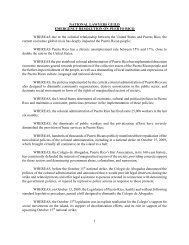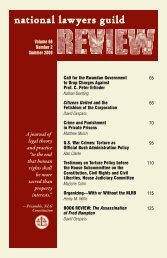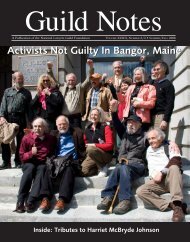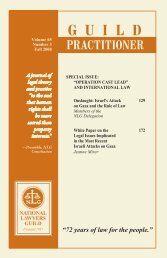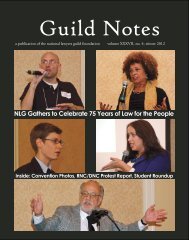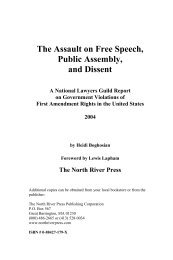NLGRev 68-2[1].indd - National Lawyers Guild
NLGRev 68-2[1].indd - National Lawyers Guild
NLGRev 68-2[1].indd - National Lawyers Guild
Create successful ePaper yourself
Turn your PDF publications into a flip-book with our unique Google optimized e-Paper software.
72 national lawyers guild review<br />
tion and Safety (OSHA) Codes, which govern legalized prostitution in the<br />
country, recommend self-defense training and classes in hostage negotiation<br />
skills. 60 Here is an example of government acknowledgment that prostitution<br />
is potentially violent for women. There are other jobs that are known to be<br />
dangerous—mining, oil drilling, construction—where recommendations are<br />
also made on how to avoid injury, but there the anticipated injuries are not<br />
crimes, as they are in prostitution.<br />
Violence is a criminal act—obtaining “consent” is no defense Some<br />
people try to make a distinction between “voluntary” and “forced” prostitution<br />
to justify legalization. The reality is, however, that violence is often the<br />
precursor to women entering into prostitution in the first place. Pimps and<br />
customers use the same methods as other abusers: denial, economic abuse,<br />
isolation, verbal abuse, threats and intimidation, physical and sexual assault,<br />
and captivity. The only difference between the behavior of pimps and johns<br />
is that money is paid. But a criminal cannot avoid prosecution because he<br />
paid the victim or the victim allegedly “consented.” A criminal act is defined<br />
by the law as an offense against societal norms, as well as against the specific<br />
victim. No degree of alleged victim “consent” can change the societal<br />
norm that represents the baseline of acceptable behavior. Thus, no amount<br />
of “consent” can de-criminalize behaviors that compromise the fundamental<br />
rights of the consenter; the state’s role as protector supersedes the individual’s<br />
right to consent in certain circumstances. Criminal law should protect women<br />
from inhuman and degrading treatment, to guarantee the preservation of their<br />
intentionally and constitutionally protected rights.<br />
Even if a woman’s consent makes a difference, consent means more<br />
than just agreeing to do an act. For a genuine choice to exist there must be<br />
informed consent and available options. Without knowledge of the reality of<br />
prostitution, women cannot make an informed judgment about their willingness<br />
to enter into the arrangement. Unfortunately, knowledge is rarely the<br />
issue. More often it is the lack of available options. The average age of entry<br />
into prostitution is fourteen. 61 At the age of fourteen a girl is not able to drive<br />
a car or bind herself in contract. A fourteen-year-old cannot consent to sex,<br />
therefore she cannot have the mens rea necessary to commit prostitution; it<br />
is a lrgal impossibility.<br />
Homelessness is the impetus for many women to enter prostitution and<br />
its long cycle of violence. Poverty-stricken Central American women desperately<br />
fleeing to the U.S. are often forced into prostitution when smugglers<br />
steal their money and border authorities deport them back to Mexico. One<br />
woman caught in this deadly cycle asks, “What else can I do now?” 62 Another<br />
asks, “I can’t go home, and I can’t tell my family where I am . . . What


![NLGRev 68-2[1].indd - National Lawyers Guild](https://img.yumpu.com/30820772/10/500x640/nlgrev-68-21indd-national-lawyers-guild.jpg)


